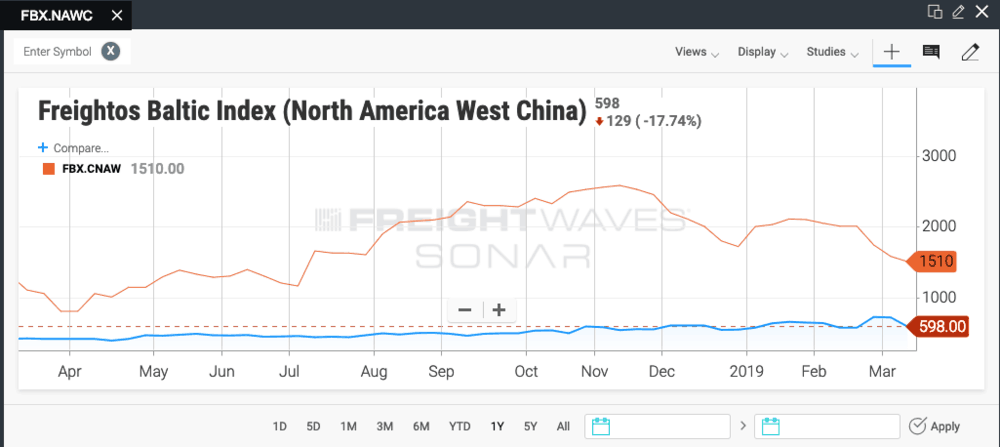Big ships come to U.S. even as backhaul cargoes still lacking, and truckers deal with terminal shut-outs and chassis imbalances.
The largest container ship ever to call on the United States is arriving this week at the Ports of Los Angeles and Long Beach, part of a 2M alliance service offering.
Big ship vessel calls are always a point of pride as they allow a port to show off their readiness to handle ever larger container ships. But big ships also illustrate the troubled economics for ocean carriers and difficulties on the landside for handling those larger ships.
The MSC Eloane, which is rated to handle 19,500 twenty-foot equivalent units (TEU), is scheduled to call at the APM Terminal at Los Angeles March 13 and Total Terminals International dock in Long Beach five days later.
The Eloane, which is regularly deployed on the Asia-to-Northern Europe route, will be the largest container ship to visit the U.S., said maritime consultancy Dynamar. The previous record was set by CMA CGM’s 17,900-TEU Benjamin Franklin.
While the Eloane’s exact manifest is unknown, according to some logistics professionals a big part of its dispatch to the U.S. will be to pick up empty containers.
The U.S. has largely always been a net importer, so a backlog of empty containers is not unusual, particularly after the holiday rush. But the imbalance is a growing concern to ocean carriers looking for backhaul cargoes.
“I am personally concerned in North America about the export situation,” Jeremy Nixon, Chief Executive Officer of Ocean Network Express, told an audience at the Journal of Commerce’s TPM 2019 conference in Long Beach last week. “We do want to see more exports coming out of the U.S.A.; of course that’s linked back to the tariff issue.”
He said monthly exports of 700,000 TEUs out of the U.S. are roughly unchanged over the last seven years. In contrast, monthly imports have risen from 1.2 million TEUs up to 1.9 million TEUs over the same time. More than half of the containers going back to Asia are empty, he added.
“We do need to get U.S. shippers and exporters back into the global market so that they are more competitive, and also for the selfish reason that we improve the equipment imbalance,” Nixon said. The imbalance “is not good for the supply chain, not good for round-trip economics of the trade.”
He added, “That’s an added cost for the carriers on a round-trip basis, which inevitably will have to come back on the import side as well.”
While the eastbound trans-Pacific ocean shipping spot rate reached as high as $2,600 per forty-foot equivalent unit (FEU) last year, the backhaul westbound rate largely remained at or below $600 per FEU. (SONAR: FBX.NAWC, FBX.CNAW)

The imbalance also hurts trucking economics for drayage as dual transactions, in which a driver can drop off an empty and pick up a full container, are curtailed. Weston LaBar, chief executive of the Harbor Trucking Association, said last week at the TPM 2019 conference that drayage operators in Southern California went from having 80 percent dual transactions several years ago to some companies seeing less than 10 percent dual transactions last year.
The upshot is that many drayage providers are providing essentially free storage for empty containers, said Robert Loya, President of the Harbor Trucking Association. If those containers are not returned with the free time allotted by ocean carriers, detention charges can also accrue.
“We are facing a myriad issues on returns,” Loya said. After the initial wave of imports, truck drivers face “nothing but restrictions on returning empties or being shut out at terminals.”
“You are delivering that empty to a different terminal than where the imports are coming in,” he added. “We are constantly sitting on empties, either at the distribution centers or at the yards.”
Dr. Noel Hacegaba, Chief Commercial Officer for the Port of Long Beach, said the 20-odd extra vessel calls from last year’s import rush “injected extra TEUs into the system. Now those have to go back.”
“We are in the process of leveling out all those additional imports we saw come in last year,” he added. “We expect that to stabilize in the coming weeks.”
Drivers also drop off chassis while returning empty containers, creating further imbalances in the chassis supply through the port, Hacegaba said. “That also affects the ability to perform dual transaction, which aims to match the outbound with the inbound.”
He said the Port of Long Beach aims to smooth out how different providers in the logistics supply chain work with one another to ease bottlenecks. He highlighted the Long Beach Container Terminal’s appointment system which allows drivers to book dual transactions as one effort aimed at addressing these imbalances.
“Technology is the tool, but it requires coordination between the terminal, the ocean carrier and the trucking company, which the port authority looks to facilitate,” Hacegaba said.
World’s largest ship broker warns on tough conditions
Clarksons’ profit falls as it warns about geo-political uncertainty and other issues affecting shipping. (Hellenic Shipping News)
BP starts selling IMO 2020 compliant fuel
Oil major says low-sulfur fuel will be available in Rotterdam and Singapore ports by 2020. (gCaptain)
Port of Virginia completes first step in expansion
Port has 12 of 30 container stacks ready as part of $700 million expansion. (Marine Insight)
Port of Rotterdam prepares for Brexit gridlock
Port readies emergency parking for up to 700 trucks that may lack proper customs documents. (Marine Link)







